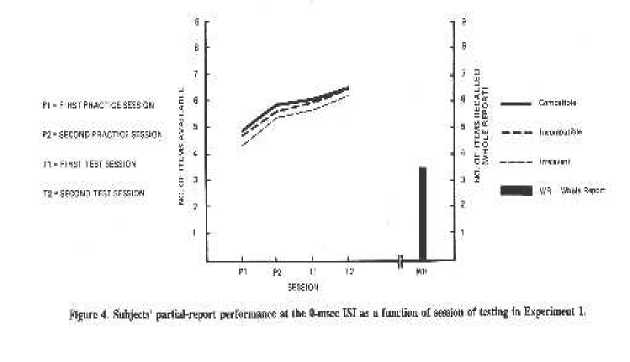5 (sessions) ANOVA with repeated measures on the latter two factors. (For this analysis,
only the session factor and all interactions involving session are meaningful.) As can be
seen from Table 3, partial-report superiority was not observed in Session 1. It was only in
subsequent sessions that partial-report superiority was found.
Table 2
The Newman-Keuls Multiple Comparison Test Between Subject' Partial-Report
Performance of Various Levels of ISI and Whole Report (Experiment 1)
|
WRa |
1000b |
500b |
150b |
0b | |
|
Recall by Row Group | |||||
|
3.58 |
4.01 |
4.65 |
5.78 |
6.78 | |
|
WR 3.58 |
0.43 |
1.07 |
2.20* |
3.20* | |
|
1000 4.01 |
0.64 |
__* |
2.77* | ||
|
500 4.65 |
1.13* |
2.12* | |||
|
150 5.78 | |||||
|
Recall by Column Group | |||||
|
3.51 |
3.98 |
4.21 |
5.11 |
5.47 | |
|
WR 3.51 |
0.47 |
0.70 |
1.60* |
1.96* | |
|
1000 3.98 |
0.23 |
1.13 |
1.49* | ||
|
500 4.21 |
0.99 |
1.26 | |||
|
150 5.11 |
0.36 | ||||
aWR=Whole report; b1000=ISI value
*Significant at the 0.5 level by the Newman-Keuls multiple comparision test. The critical
values for two-, three- and five-step diffeences are 1.09, 1.32, 1.45, and 1.55,
respectively.

Figure 4. Subject's
partial-report
performance at the 0-
msec ISI as a function of
session of testing in
Experiment 1.
More intriguing information
1. Skill and work experience in the European knowledge economy2. Innovation and business performance - a provisional multi-regional analysis
3. The name is absent
4. The name is absent
5. Picture recognition in animals and humans
6. Reconsidering the value of pupil attitudes to studying post-16: a caution for Paul Croll
7. Kharaj and land proprietary right in the sixteenth century: An example of law and economics
8. EMU: some unanswered questions
9. Evolving robust and specialized car racing skills
10. Input-Output Analysis, Linear Programming and Modified Multipliers